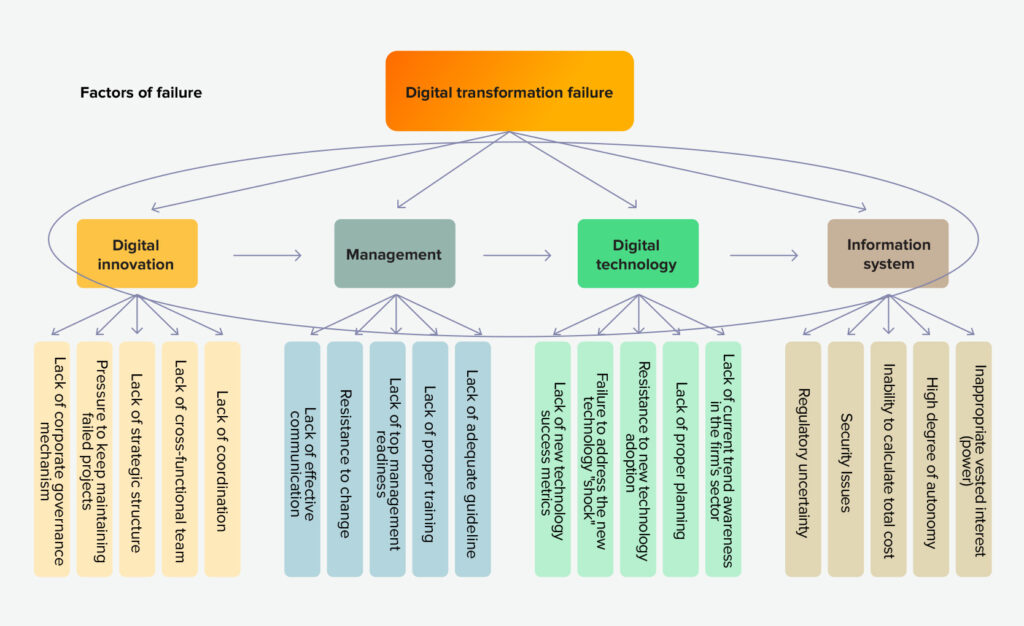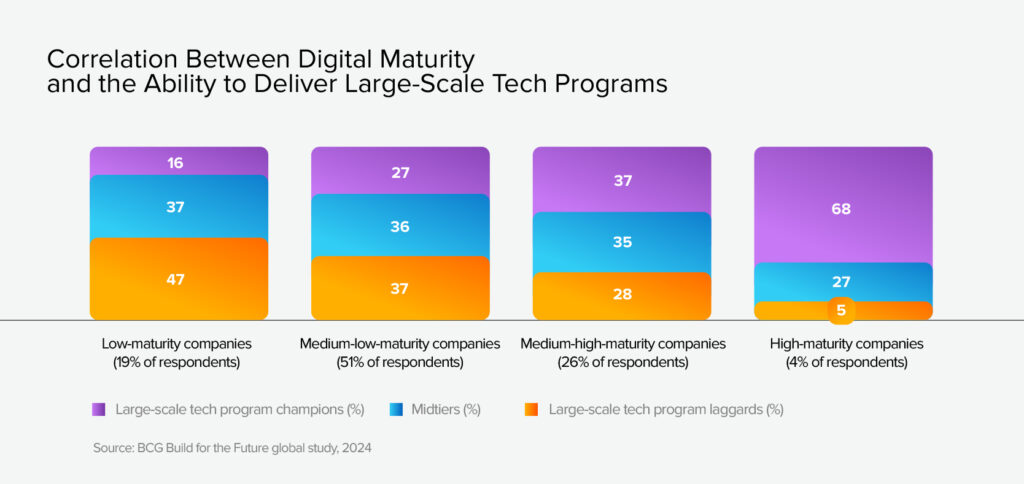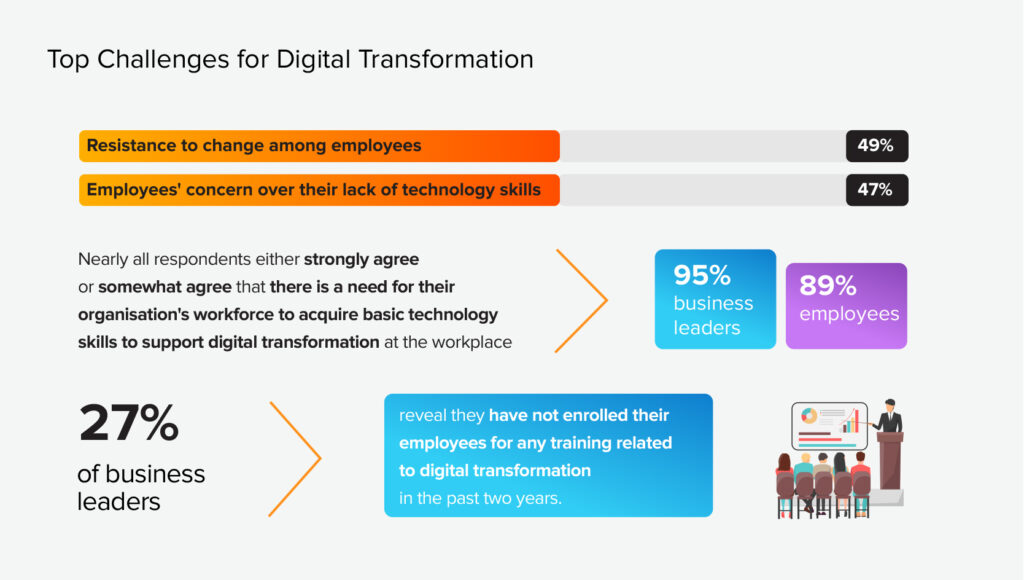Year after year, digital transformation remains a fixture atop corporate agendas, prominent in boardroom conversations and generously funded in annual budgets. Global investment is edging toward the $4 trillion mark. And yet, for all the capital deployed, the returns are often elusive. Only a third of transformation efforts deliver measurable business growth.
It’s a pattern that forces a quiet reckoning. Technology, despite the rhetoric, is not a panacea. It is a medium – one that, at best, amplifies sound strategies, strong leadership, and well-functioning systems.
For many organizations, the inability to leap forward stems not from a lack of vision but from accumulated complexity – legacy systems, siloed teams, unclear governance. A digital transformation readiness assessment serves as a kind of diagnostic. It helps identify what’s holding you back, where momentum is possible, and how to chart a path that aligns ambition with operational reality.
Why is Digital Transformation Readiness Important for Organizations
Digital transformation (DT) readiness assessments help organizations map their current baseline, set strategic objectives, and prioritize key actions for reaching the desired next-stage capabilities. Think of it as a map that represents the “uncharted territories” – fragmented infrastructure, full data estate, all business processes, and cultural practices.
Without this foundation, even the best transformation strategies risk sidelining or magnifying their scope without delivering the intended impacts. Unfortunately, many of these do go wrong. On average, two-thirds of large-scale tech programs exceed original timelines, scope, and budget by €20 million per year.
Key Reasons Behind Digital Transformation Failures

Source: ScienceDirect
On the other hand, with a digital transformation readiness assessment, you can:
- Avoid costly missteps. Companies that pursue “random acts of digital” – isolated tech initiatives without strategic alignment – risk wasting up to $1.5 trillion globally. A readiness assessment aligns digital investments with measurable business outcomes, ensuring each initiative is warranted and sequenced correctly.
- Address risks and blockers early on. DT readiness assessments help surface technical debt, integration constraints, security gaps, and missing capabilities before they derail implementation. This proactive approach reduces downstream firefighting and sets realistic expectations for timelines and outcomes.
- Secure stakeholder buy-in. With clear benchmarks and a shared understanding of where the organization stands, it's easier to align leadership around the vision. According to Gartner, many transformation shortfalls stem from siloed efforts and poor alignment between IT and business stakeholders.
- Drive measurable future growth. By prioritizing the right digital investments and operating model shifts, organizations can scale more efficiently and unlock new revenue streams. A readiness-backed roadmap enables faster value realization and sustained market advantage.
How Does Digital Transformation Readiness Impact Business Competitiveness?
Digital transformation readiness indicates your ability to capitalize on emerging market trends and capture digitally-enabled revenue. Between 2018 and 2022, digital leaders generated 8.1% in average annual total shareholder returns versus 4.9% of laggards due to stronger market positioning, better customer experience levels, and higher overall profitability. Given that most business is now done online, being digitally prepared isn’t a ‘nice-to-have’ – it’s a competitive necessity.
Digital Transformation Readiness Checklist: Key Dimensions To Evaluate
The goal of a digital transformation readiness assessment is to identify how well-positioned your company is – strategically, operationally, culturally, and technologically – to evolve in lockstep with digital demands and opportunities.
As part of our digital transformation services, we run rigorous business analysis to determine possible friction points, innate organizational strengths, and trapped opportunities within the following eight dimensions:
- Strategy and governance. Do you have a clear rationale for becoming digital, supported by measurable goals and a decision-making framework? Strong governance ensures digital initiatives result in proven value and helps maintain accountability throughout execution.
- Leadership and vision. Is your C-suite committed to doing the hard work and can rally cross-functional teams? DT succeeds under leaders who champion change, communicate a compelling vision, and model digital-first thinking.
- Digital culture and mindset. Is your organization open to change, experimentation, and continuous improvement across all levels? An adaptable, growth-oriented culture is key to sustained transformation.
- Technology and infrastructure. What’s the state of your current IT landscape? Legacy systems, siloed platforms, and low cloud readiness can slow down innovation and limit responsiveness.
- Talent gaps and skills readiness. Do you have the right capabilities in place? These include in-house skills, upskilling strategies, and access to external expertise for emerging technologies.
- Data readiness. Do you have mature data governance practices, integration architecture, and strong data analytics capabilities? Reliable, high-quality data and modern data pipelines are integral to digital transformation.
- Workflows and processes. How digital and automated are your core business processes? Fragmented, manual workflows often signal where transformation can yield quick wins in speed, accuracy, and cost.
- Innovation and learning. How well does your company foster experimentation, pilot new ideas, and integrate lessons learned into future initiatives? A strong innovation engine keeps transformation moving forward rather than stalling after initial wins.
| DT component | Description |
|---|---|
| Strategy and governance | Alignment of digital goals with business strategy, supported by governance frameworks and KPIs. |
| Leadership and vision | Executive commitment to digital transformation, ability to inspire teams, and communicate a clear long-term vision. |
| Digital culture and mindset | Organizational openness to experimentation, adaptability, and continuous improvement in a digital-first environment. |
| Technology and infrastructure | Evaluation of current IT systems, cloud readiness, integration maturity, and scalability of digital platforms |
| Talent and skills readiness | Assessment of in-house capabilities, skills gaps, upskilling programs, and access to critical digital expertise. |
| Data readiness | Quality, accessibility, and governance of enterprise data; ability to turn data into actionable insights. |
| Workflow and processes | Level of automation, process standardization, and optimization for efficiency and agility. |
| Innovation and learning | Capacity to support pilots, scale innovation, and apply feedback loops for continuous digital evolution. |
How Does Digital Transformation Readiness Vary Between Small and Large Enterprises?
Digital transformation readiness levels differ by a notch between SMEs and larger enterprises. Statistically, SMEs often start by digitizing basic functions like marketing or operations and show less of a digital gap in areas like e-invoicing or government interactions. But the divide widens with complex tools like ERP, ECM, or CRM. Overall, larger companies are more capable of adopting advanced technologies (generative AI, predictive analytics, RPA, etc), while SMEs rely on managed IT services, SaaS, or platform-driven solutions to bridge capabilities gaps and keep costs down.
How to Conduct a Digital Transformation Readiness Assessment: Key Steps
Knowing that transformation is necessary is one thing. Figuring out how to do it well is another. A digital transformation readiness assessment helps you understand your readiness levels for large-scale tech initiatives, which is a key factor of success.

Source: BCG
Below, we’ll walk you through the essential steps – from setting clear objectives to building a practical roadmap – so you can turn vision into measurable progress, without the chaos.
Define Strategic Objectives and Scope
Digital transformation is a lofty term. It can mean vastly different things to different businesses. For some companies, like our client – an EdTech company – it’s centered on legacy platform modernization, which hindered product growth and user experience. For others, like a cybersecurity company, DT had a greater focus on building unified data analytics and operational workflows.
To prioritize the key transformations, you must establish overarching end-goals and success metrics – something 92% of digital transformation champions do. DT objectives will steer every choice you make throughout the transformation journey (and help you avoid costly detours). That clarity is what turns transformation from a buzzword into a business advantage.
Yet, not all goals are created equal. “Improving customer experience by reducing onboarding time 40% with a conversational AI assistant” is a strong objective. It’s specific, measurable, and tied to business value. On the other hand, vague objectives like “adopt AI” or “modernize IT” mostly end with a whimper rather than a bang.
| ✅ Good digital transformation objectives | ❌ Bad digital transformation objectives |
|---|---|
| Clear, outcome-driven, and aligned with business value: Reduce ticket resolution time by X% with AI-driven customer service solutions Increase logistics team productivity by X% via robotic process automation Trim cloud infrastructure by X% by improving data storage architecture | Vague, tech-led, or disconnected from business outcomes: Add AI and machine learning to our main product Go digital across all departments to improve staff productivity Modernize our technology stack to reduce operating costs |
To further prioritize your goals, consider the broader market landscape. If your industry is relatively stable and disruption isn’t knocking at the door, focus on optimizing existing capabilities to achieve near-term benefits. Otherwise, full-scale transformation could become a costly effort that outpaces customer demand. For example, implement new software development best practices and DevOps toolchains to streamline engineering cycles or implement better data analytics in marketing to improve campaign yields.
But if you’re in a sector already facing rapid disruption, delaying digital transformation can be risky, potentially costing you market share, revenue, and relevance. Being an “early mover” also pays off in sectors with tough competition. For example, in the hospitality sector, Hilton was the first to embrace digital transformation during the pandemic, launching contactless guest experiences and data-driven personalization, moves that helped them maintain the world's most valuable hotel brand title for several years.
Once your overarching goals are defined, you can work backward to identify the actions and capabilities needed to reach them, aka the scope of transformation. A strong assessment typically covers your tech stack, data capabilities, workflows, leadership alignment, and culture. But here’s the trick: don’t try to fix everything at once. Instead, zoom in on high-impact use cases or friction points that matter most to your business now. This keeps the assessment grounded and your roadmap realistic.
Choose an Assessment Framework
A DT readiness assessment is only as good as the framework behind it. The right framework helps you methodically identify missing capabilities, clarify priorities, and select the best methods to deal with both. It brings structure to an otherwise chaotic process, making it easier to evaluate your current state across people, processes, and technology.
At Svitla Systems, we’re big fans of the next three digital transformation assessment frameworks:
- Gartner Digital Business Maturity model helps organizations assess their digital maturity across five progressive stages – from initiating to optimizing – by evaluating business models, leadership, and capabilities. It’s an effective tool for scoping your digital ambition and identifying what needs to evolve to support long-term digital growth.
- Deloitte’s Digital Maturity Model evaluates digital readiness across five domains: customer, strategy, technology, operations, and organization & culture. What sets it apart is its emphasis on actionable benchmarks for each domain, enabling clear prioritization and progress tracking.
- McKinsey’s 7S Framework, in turn, examines how seven interdependent elements: strategy, structure, systems, shared values, style, staff, and skills shape the company’s performance. While it’s not digital-specific, it helps surface organizational misalignments – a common challenge of digital transformation processes – and figure out how your people can work better together.
Effectively, an assessment framework helps you create a shared language between different stakeholders and a structure for prioritizing the next steps.
Collect and Analyze Benchmarking Data
To understand where you stand and what’s holding you back, you’ll need a mix of qualitative and quantitative inputs from different units. As part of our digital transformation readiness assessment, we usually gather the following data:
- Current IT systems inventory and architecture documentation
- Process maps and automation levels
- Digital skills and workforce capability assessments
- Customer experience and engagement metrics
- Data governance policies and data quality audits
- Culture and change-readiness surveys
- Strategic alignment between business and IT
- Existing digital initiatives and performance benchmarks
To collect this data, start with stakeholder interviews and team workshops to gain richer context behind the numbers. Pair that with internal documentation reviews, system audits, and analytics from your CRM, ERP, or workflow tools. Use employee surveys to assess culture and digital literacy, and pull data from HR systems to analyze skills gaps. For customer-facing metrics, mine the voice of customer data, NPS scores, and digital engagement patterns.
When it comes to evaluating the data, lean on your chosen framework. Use it to score each domain against maturity benchmarks or peer baselines, and look for patterns. Where is performance lagging? Where are there misalignments, and what’s blocking progress?
Keep your analysis objective, but contextual: numbers alone don’t tell the full story unless you understand the “why” behind them. That’s where the insight (and the next big opportunity) lives.
Outline Key Areas for Improvement
The collected data should give you a good grasp of where you’re falling behind. Most businesses naturally try to focus on the “big picture problems” – low productivity, eroding profit margins, or slow product releases.
But it pays to go more granular and choose narrower areas, where you have clear stakeholder ownership and a visible return on effort. For example, digitizing guest services in hospitality to reduce operating costs and improve CSAT or implementing data analytics for more personalized investment management are high-impact areas to target.
Generally, it pays off to start with low-hanging fruit – initiatives that are relatively easy to implement but drive immediate value. These quick wins build momentum and trust, especially in organizations where change resistance is high. Over time, you can layer in more complex efforts once the foundational capabilities are in place (and bringing ROI).
Rather than chasing massive transformation every quarter or year, many digital leaders find success in taking an iterative, high-frequency approach. Take Thomson Reuters, for example: by shifting 95% of its core products to the cloud and revamping its engineering processes, the company moved from quarterly to weekly product updates. In just six months, the company launched seven new generative AI products – a pace that would’ve been impossible under a traditional, big-bang approach.
Our advice is to prioritize digital transformation initiatives that are both strategic and achievable. Build a backlog of improvements that can scale over time. That way, you build up “transformation velocity”, which continues to propel you ahead year after year.
Build a Roadmap to Implement Change(s)
A well-structured digital transformation roadmap turns strategy into execution. It should clearly define initiatives, assign owners, and set realistic timelines and targets for every business unit involved.
Remember: the average large-scale digital transformation takes 2 to 3 years, so avoid the trap of over-committing. Also, ensure you have the budget locked in for each phase with a buffer. Over 80% of enterprises report failed or delayed transformation efforts, and scaling back costs an average of $4.55 million per company.
We recommend starting with lighthouse projects – high-impact, low-risk initiatives that generate early wins and prove value. Whether it’s automating a core workflow or launching a customer-facing app, these projects help gain traction, build momentum, and win over skeptics.
But even the best roadmap will stall without buy-in. Resistance to change is the main reason for stalled digital transformation, closely followed by low digital literacy among the workforce. When people don’t have the right skills (and leadership isn’t clear about what’s changing), it’s easy for new tech to feel intimidating instead of exciting. Confusion takes over, and curiosity gets replaced with hesitation.

Source: NTUC LearningHub
To overcome workforce resistance, strong stakeholder engagement and grassroots support are essential. Invest in change management practices: involve cross-functional teams early, co-create new ways of working, communicate outcomes (not just tasks), and celebrate small wins.
AstraZeneca offers a standout example of effective digital transformation change management. Since 2023, they’ve taken a methodical, agile approach to change, shifting from a center of excellence to a center of enablement model. By embedding feedback loops, launching internal playbooks and dashboards, and prioritizing coaching, they built a system that moves fast without losing alignment. Their motto? “Deliver value faster than the customer can change their mind.” That mindset, paired with lean governance and talent agility, has helped AstraZeneca scale transformation and adopt AI for healthcare research.
Your digital transformation roadmap is more than a schedule. It’s a transformation playbook. Make it actionable, flexible, and deeply connected to people.
Conclusion
Digital transformation doesn’t start with shiny new technologies – it begins with clarity. To succeed, you need a clear-eyed view of where an organization stands, what obstacles lie in its path, and what steps are required to move forward. Define your goals, choose a framework that reflects the realities of your business, and convene the right people to begin the work.
For those seeking deeper support, Svitla Systems offers end-to-end guidance – from conducting comprehensive readiness assessments to shaping and implementing transformation roadmaps. Contact us for more details about our service lines.

![[Article] Digital transformation](https://svitla.com/wp-content/uploads/2025/06/Article-Digital-transformation-936x527.jpg)


![[Blog cover] Digital transformation technologies in healthcare](https://svitla.com/wp-content/uploads/2025/02/Blog-cover-Digital-transformation-technologies-in-healthcare-560x310.jpg)